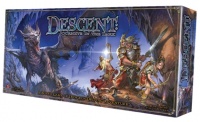 Rolling for Initiative is a weekly column by Scott Thorne, PhD, owner of Castle Perilous Games & Books in Carbondale, Illinois. This week Thorne looks at the problems associated with trying to have the top selling boardgames in stock throughout the holiday season.
Rolling for Initiative is a weekly column by Scott Thorne, PhD, owner of Castle Perilous Games & Books in Carbondale, Illinois. This week Thorne looks at the problems associated with trying to have the top selling boardgames in stock throughout the holiday season.It’s that time of the year, when chestnuts are roasting on an open fire, Jack Frost is nipping at your nose, shoppers are hustling and bustling and out-of-stocks proliferate. We tried restocking a couple of our more popular (at this time of year) boardgames last week and found our regular distributors out of stock on both of them. Since this sort of thing happens on a regular basis this time of year, we had wisely stocked up heavier on these game lines than we normally would in March or August, so we should have enough to carry us through the 25th. Still, it’s annoying to have to deal with this every year. Of course, the reason we have to deal with it every year is the same reason our store doesn’t stock twice as many as we should: bulk and cost.
Boardgames are bulky. Fantasy Flight Games’ bestselling boardgame, at least in our store, is Descent, which clocks in at almost 2 feet long and 4 inches thick. Days of Wonder’s Ticket to Ride, about a foot square and 3 inches thick. Even Mayfair Games’ Settlers of Catan series takes up a good foot on the shelf and is also 3-inches thick. Most game stores I’ve seen in the last couple of years, to face a boardgame out, only have enough room for two to three copies of any individual game to fit on the shelf. Yes, you can turn them on edge and fit a lot more games into the same area but you’re losing the eyecatching appeal of that really nice cover the publisher spent a lot of money to have created and painted, so we have a trade-off of either greater product selection or more visual appeal.
This also means that, if a store wants to stock extra backstock, it has to find a place to put it. Most game stores don’t have a lot of merchandise space (the term used to describe storage space for overstock), so any extra stock brought in to shore up possible holes during the holiday selling season generally has to go someplace out on the sales floor, either taking up space that could be devoted to other products or disrupting the display as the store tries to fit the additional product in someplace. Those stores with extra merchandise space have to deal with the problem that not everyone may know where the backstock is kept so when it sells out, if a knowledgeable staffer is not on duty, the backstock gets overlooked or forgotten.
The other problem, of course, is inventory investment. We’re seeing upward price creep on boardgames from a number of publishers and it can require a significant investment to keep enough stock of a $90 boardgame on hand to satisfy expected demand over the holidays. With the markup on products in the gaming industry running less than keystone on many top selling products, the store owner have to do some significant analysis to determine where to allocate scarce dollars. A wrong decision on how many of a boardgame to bring in can result in liquid assets getting tied up in inventory for a much longer period that the store sees as desirable.
It all winds up a financial juggling act. How many copies can I afford to bring in, given the amount of capital and display available and the likelihood they will go OSM when I need more. Maybe I’ll get it right this year.
The opinions expressed in this column are solely those of the writer, and do not necessarily reflect the views of the editorial staff of ICv2.com.


